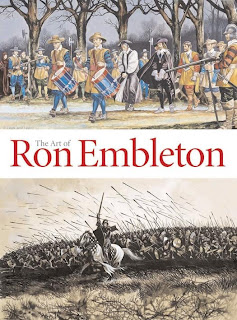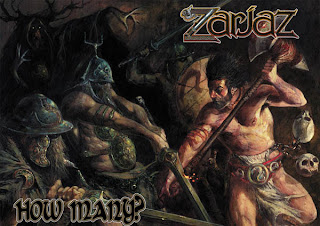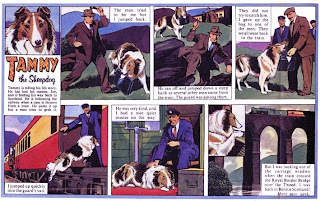
Here's the first of a couple of tales I'm classifying as "Mysterious Tales of Romance Writers". I've covered a fair number of curious cases where author's names have changed over the years but that seems to be more prevalent amongst romance authors than any other field (see, for instance, the case of Kathleen Cornwell
here). Trying to track down authentic information—even something as simple as a birth or death record—can turn into a hugely convoluted affair. A colleague of mine, John Herrington, has been looking for information recently and a few of the bylines he has mentioned have turned out to have quite interesting tales behind them. You know me... I hate to let research go to waste, so here's the first of our "Mysterious Tales of Romance Writers"...
Sybil Campbell Lethbridge was born Sybil MacGregor C. Allen at St. Giles, London, in 1873, and came from an old West Country family, although she herself preferred London. She supposedly grew up in part in Cornwall [according to one brief bio I read, but I suspect that should be Somerset, see below] but was educated abroad and lived out of England a great deal. Because of this, she left very little information behind in official records.
Her parents John Allen, born in Somerset in c.1827, and his wife Elizabeth, born in Thornton, Gloucestershire, in c.1835. They had 10 children...
William Cross Allen (1854- )
James ___ Allen (1855- )
John Allen (1857- )
Percy Edward Allen (1859- )
Alice Geraldine Allen (1861- )
Alexandra Gertrude Allen (1863- )
Sarah Elizabeth Allen (c.1864- )
Maria Grace Allen (c.1865- )
Margaret Frances Allen (1868- )
Dianna M. Katherine Allen (c.1870- )
The couple lived for almost two decades in Burnham, Somerset, where John was a brewer. In around 1869, the family moved to Charlinch, near Spaxton, Somerset, where they took over a farm of some 141 acres which employed 7 farmhands and 2 boys. John Allen would appear to have died soon after, in 3Q 1870 (certainly a 44-year-old of that name is registered at Bridgwater, the administrative town of the Sedgemoor district of Somerset).
The big mystery here is how could Sybil McGregor C. Allen (sister of Margaret Frances Allen and daughter of Elizabeth Allen) have been born in 1873; and why was she born in London when her siblings and parents lived in Somerset?
This is not the only mystery.
In 1894 she married William A. E. Lonergan in Blean, Kent, and when I did a little digging into his life, he turned out to be something of a Raffles.
William Lonergan (1813-1877) married Caroline Emma MacNolty (Liege, Belgium, 1824-Paris, France, 11 May 1898), daughter of Patrick MacNolty on 5 July 1857. She already had one child, John Marmaduke Joseph Stourton, 1847-1899) from her first marriage to John Joseph Stourton (1816-May 1847), who died seven days before his son was born.
William and Caroline had two children before they divorced in 1866: William Alfred Ernest Lonergan, born at Hyde Park, London, on 11 May 1859, and Arthur Charles Everard Lonergan (1861-?).
William, described as a "Gentleman", had a bright career in the army and was promoted to 2nd Lieutenant of the 1st Warwick on 23 February 1878 and then to Lieutenant on 18 June 1879. He subsequently transferred to the 66th (Berkshire) Regiment and, in May 1881, was presented to the Prince of Wales by Lt.-Col. Hogge. Lonergan had been involved in the Maiwand action in Afghanistan and was one of the few surviving officers.
A few months later, in December 1881, Lonergan was accused of the theft of two shirt-studs (one emerald, one diamond) and two scarf-pins from the house of a friend, Hugh Wegelin, on 26 November 1881. Wegelin had shared a house with Lonergan when the two were living in Paris in around 1877. A police inspector interviewed Lonergan at his mother's home at 89 Elizabeth Street, Eaton Square: he claimed he had found the jewels and sold some of them to a pawnbroker. Lonergan was committed to trial in January but failed to appear. A warrant was issued for his arrest on 30 January 1882 but Lonergan disappeared completely for a decade. He was immediately dismissed from the army.
It was not until October 1892 that he entered Scotland Yard and gave himself up. He was tried on 14 November 1892, found guilty and sentenced to four months hard labour. (Details of the trial can be found
here.)
Lonergan then married Sybil MacGregor C. Allen in Kent in 1894. She was aged 20 or 21 and it would seem that the newly married pair moved abroad because the next sign of her, under the name Mrs. Sybil Campbell Lethbridge, is in the 1901 census where she was living with her unmarried sister, Margaret F. Allen, at 19 Handforth Road, Lambeth, London. Her occupation is as an author.
Now, how Sybil Lonergan become Sybil Lethbridge is unknown. What is known is that, although married in 1901, she was soon widowed and, following her husband's death, settled in London at 28 Edwardes Square [1906/28]. "She is very fond of reading, and in her little garden has the scope for her love of gardening, having persuaded many flowers to grow in it to which hitherto London soot and smoke have been considered fatal."
She was a popular and prolific writer and was said to have "one gift that many authors, however brilliant and gifted, do not possess, and that is the power of arousing from the very first phrase the interest of her readers, and of keeping it to the concluding words. The reason for this is probably to be found in the fact that she enjoys writing her books so much that it is impossible not to enjoy reading them. She is a very rapid worker, and very methodical. As a rule her stories are founded upon some incident in real life. Everything, she says, suggests romance to her, and one of her most successful tales was founded upon a chance phrase she overheard at a dinner-party."
She had began writing as a child. "My first books were mostly startling and lurid melodramas that came, as a rule, to an abrupt end, owing to most of the characters dying in some violent fashion in the first chapters," she said on one occasion. Only one of her youthful efforts survived her childhood, a historical under the forbidding title
Children of Cain.
Her contributions appeared in
Horner's Pocket Library,
Tit-Bits Novels and
Smart Novels, and a number of her books were serialised in
The Star newspaper, including "Her Fight With Fate" (1913), "The Serpent's Tongue" (1915), "Market Value" (1919), "False Heart and True" (1920) and "Fair Game" (1922).
After departing Edwardes Square, Sybil Campbell Lethbridge lived at various addresses in Wiltshire: Ivy House, Worton, Devizes [1929/35], The Angel, Lacock [1936], and Abbey House, Milton Lilbourne, Marlborough, Pewsey [1937/43].
She died in early 1945, aged 72, her death registered in Devizes.
NovelsThe Shoreless Sea. London, Holden & Hardingham, 1912.
Love and My Lady. London, Holden & Hardingham, 1913.
The Shoreless Sea. London, Amalgamated Press (Fiction Lover's Library 8), Jan 1914.
Middle Life. London, Holden & Hardingham, 1915.
Let Be. London, Methuen & Co., 1916.
The Marauders. London, Aldine Publishing (Mascot Novels 57), May 1917.
One Woman's Hero. London, Methuen & Co., 1917.
The Sins of the Children. London, Holden & Hardingham, 1918.
The Journey Home. London, Skeffington & Son, 1919.
Misfits. London, Skeffington & Son, 1920.
The Crooked Tree. London, Hurst & Blackett, 1922.
Hard and Fast. London, Hurst & Blackett, 1923.
Gnats and Camels. London, Hurst & Blackett, 1924.
"You'll Love Me Yet!". London, Aldine Publishing (Aldine Novels 5), Oct 1924.
The Hidden Chain. London, Aldine Publishing (Mascot Novels 217), 1924.
The Odds Against Her. London, Hurst & Blackett, 1925; abridged, London, Mellifont Press, 1934.
Out of Bounds. London, Methuen & Co., 1927.
Tawny Eyes. London, Methuen & Co., 1929.
The Crime of Jane Dacre. London, Methuen & Co., 1930.
Common to All. London, Methuen & Co., 1930.
Her Double Life. London, D. C. Thomson (Red Letter Novels 286), 1931.
The Long Day's Task. London, Methuen & Co., 1931.
The Lover She Stole. London, D. C. Thomson (Red Letter Novels 276), 1931.
A High Flier. London, D. C. Thomson (Red Letter Novels 325), 1933.
The Wild Feather. London, Methuen & Co., 1934.
Sweet Fruit. London, Methuen & Co., 1935.
A Woman's Battle. London, William Stevens (New Moon Series), 1935.
The Tempter's Snare. London, Mellifont Press, 1936.
To Love at Last. London, Mellifont Press, 1937.
Won by Fraud. London, Mellifont Press, 1937.
An Island Wooing. London, Mellifont Press, 1938.
The Courage of Anne Carew. London, Mellifont Press, 1939.
From Gloom to Gold. London, Mellifont Press, 1939.
Seeing Life. London, Mellifont Press, 1939.
Caught in the Toils. London, Mellifont Press, 1940.
A Fight for Love. London, Mellifont Press, 1940.
Old Hillersley's Heiress. London, Mellifont Press, 1940.
A Poor Relation. London, Mellifont Press, 1940.
Two Loves. London, Mellifont Press, 1942.
When Love Conquered All. London, Mellifont Press, 1942.
The Golden Snare. London, Mellifont Press, 1946.
OthersThe Christ of the Forest by Robert Michel, translated from
Jesus im Böhmerwald by S. C. Lethbridge. London, Methuen & Co., 1930.
 PRE-SCHOOL MAGAZINES
PRE-SCHOOL MAGAZINES COMICS / MAGAZINES
COMICS / MAGAZINES (* Fun to Learn—Friends © Redan; High School Musical The Official Magazine © Panini UK.)
(* Fun to Learn—Friends © Redan; High School Musical The Official Magazine © Panini UK.)





















































































